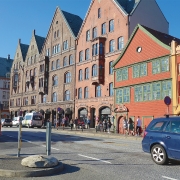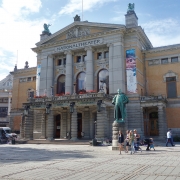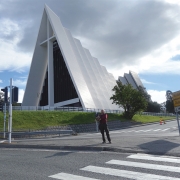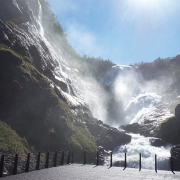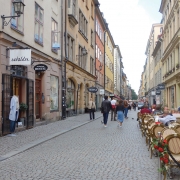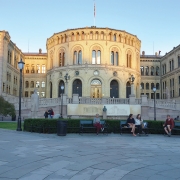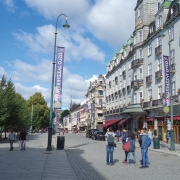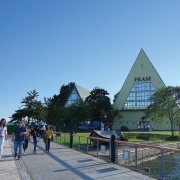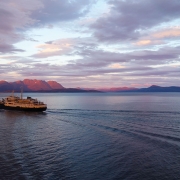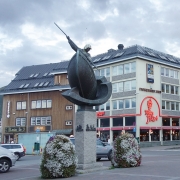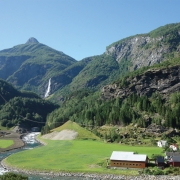
Etcetera
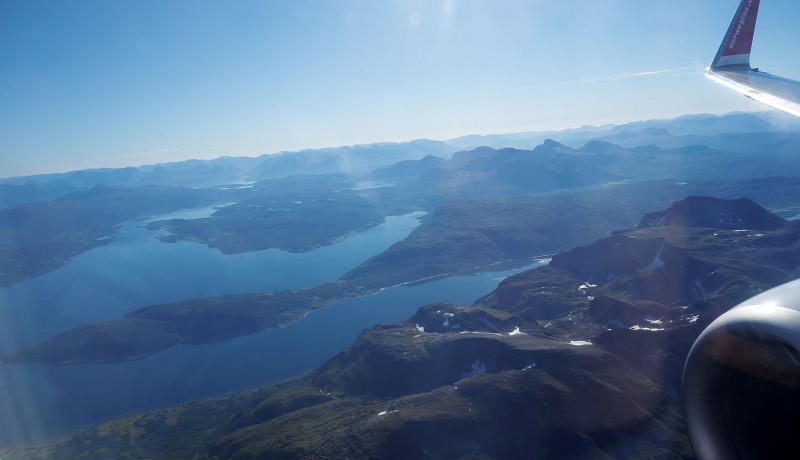
Northern lights and midnight sun apart, Norway is laced with ruffled fjords, rugged mountains and green belts
As our aircraft descends in Oslo, a collage of shimmering waters and undulating mountains comes into view. Norway, a name coined by Anglo Saxons, means the ‘way leading to the north’. Sitting pretty on the western and northern arm of the Scandinavian peninsula, 60 per cent of the land is dominated by rugged mountains enclosing glassy lakes. These ranges speak of the Ice Age, of mammoth glaciers that slid down into the sea, corrugating the edges, creating ruffled fjords and speckled islands along its long coastline. Thirty-seven per cent of the surface area is forested, making it one of the most beautiful countries on Planet Earth, where heavenly skies merge with the waters and panoramic landscapes unfold to take your breath away.
This land of midnight sun and enigmatic northern lights is not only about the great outdoors. Norwegian cities have all the cosmopolitan trappings, with slick Scandinavian architecture, restaurants, shopping and vibrant cultural life. And so, over the next eight days, our Nordic vacation will unfold an enchanting swirl of nature laced with urban delights as our itinerary spans cross-sectional glimpses of the country, westwards to Bergen, gateway to the fjords, and then moving extreme north to enjoy high latitudinal thrills, 350 km across the Arctic Circle to Tromsø.
We make a head-start with the capital city. It is 8 pm and a long summer day is giving itself over to the night as we arrive at Smart Hotel, where we are booked. Like its name, the hotel accepts payments with smart cards only, even if it’s breakfast or simply a cup of coffee. This management outlook perhaps synchronises with Norway’s progressive modernism. Yet, Norwegians love their traditions, and honour their constitutional monarchy that presides over a parliamentary democracy. The old and the new, Oslo exhibits this striking mix of character.
First, a quick look downtown to Karl Johans Gate, where we sample Oslo’s nightlife, with a choice of international cuisine restaurants, nightclubs and pubs rocking with music. This is the pivotal boulevard of the city and the next morning we traverse it again on our way to the harbour. It is a beautiful tree-lined pedestrian street with flowerbeds and a bubble fountain in its central square, expressing 19th century grandeur in the architecture of its buildings. We cross the Grand Hotel dating to 1874, where celebrated Norwegian playwright and poet Henrik Ibsen lunched daily and penned his thoughts. The hotel hosts the annual banquet for the winner of the Nobel Peace Prize—the only Nobel award that is presented in Norway and not in Stockholm.
Over the next three days, we shall do a lot more sightseeing around this area. An avenue on the western side leads to the Royal Palace. Regal edifices like Stortinget or Parliament and the National Theatre afford some wonderful photo opportunities.
Towards the eastern end of the street stands the baroque Oslo Cathedral and surrounding bazaar. Cafes abound; we can’t resist lunching at an eatery with a board that states: ‘Beauty lies in the eye of the Beer holder!’ Then again, stylish stores set in gracious buildings tempt us to tarry and browse.
Juxtaposed with the neoclassic is the stunningly futuristic architecture. For instance, the Opera House is a contemporary beauty in white marble and granite. Its angled design rises like an iceberg against the blue waters of Oslofjord. Its massive framed glass panes admit the sky into the foyer. From the ground level, visitors can walk right up to its roof by way of external ramps. In the defunct shipyard nearby, the ‘Barcode’ district is an expression of line and space. These are closely spaced corporate buildings in black and white with facades that resemble the pixels of a barcode.
The Vigeland Sculpture Park, the life work of Gustav Vigeland, has over 200 modernistic sculptures in bronze and granite. Oslo has art galleries and museums galore. Norwegian expressionist artist Edvard Munch’s masterpiece The Scream at the National Gallery is a crowd-puller. We take the ferry to Bygdøy peninsula. A walk through lush environs leads us to the Viking Ship Museum, where ships with curved hulls are among the highlights. The Fram Museum shares interesting insights about Norwegian polar expeditions.
We set aside half a day for a cruise along Oslofjord. As our boat moves out, the medieval Akershus fortress that was built to protect Oslo at the edge of the waters recedes, while a cool sea breeze whips up light clouds that weave fascinating patterns in the sky. Facing the waterfront is the elegant building of the Nobel Peace Centre that merits a tour. The prize ceremony is held at Oslo City Hall, an impressive edifice, also along the harbour. A brown stone configuration in three blocks, its colossal central hall with a grand staircase and skylights has murals and paintings depicting Norwegian cultural life.
On our last day, we go out to the charming suburb of Holmenkollen by metro to see the ski jump that has witnessed over a century of ski championships. An elevator goes up to the 60-m jump tower from where a swirling slope stretches out. Though the ski museum is of interest, we are bewildered by our daring to venture a ride in the ski simulator, which leaves us gasping!
After action-packed Oslo, our next stop Bergen, Norway’s second largest city, is a short flight, but we’d rather take the train, which is worth every minute of its seven-hour journey. Our eyes remain peeled to the window, nature revealing its magnificence, as the train goes through different elevations. Initially, it glides along the road edged with calm waters and mountains visible through alpine trees. As it goes over rocky heights, the train goes through tunnels, each time emerging to extract joyful exclamations from us. The landscape changes with bare snow-spangled mountains casting mirror images in the blue waters of reflective lakes. Closer to our destination, threads of silvery waterfalls course through green forests that inhabit the lower ranges.
Bergen is endearingly draped over the mountainsthat surround its harbour, busy with cruise ships, yachts and fishing boats. By the pier, the historic fish market now wears a contemporary face with its expansive glass-paned market hall, with an upper level tourist information office where we book our Sognefjord cruise tour. Across the bay is the UNESCO heritage medieval town of Bryggen, rows of slant-roofed wooden Hanseatic League’s merchant houses in colours of ochre, blue, brick red and brown: Bergen’s poster icons, and justifiably so.
The city has a funicular for mountain views, and its share of museums and churches, while downtown has chic shopping, but we simply walk through the cobbled lanes and hilly streets to soak in the charm. The central City Park with its cast iron circular gazebo encrusted by flower beds is delightful. Nearby stands the National Theatre built in 1909, at the initiative of Ole Bull, Bergen’s famous violinist whose statue resides under a large tree.
Our Sognefjord tour starts early next morning with a train to Myrdal. There is a flurry of excitement among fellow passengers as we transfer to Flamsbana, a heritage train built in 1924, which will take us on what is rated as one of the world’s most scenic train journeys. The train, with its wooden interiors, is a quaint marvel as it negotiates its way down to Flam, which is almost at sea level, making it the steepest ride on a regular gauge track for any European railway. The carriages are outfitted with a screen that map the 20-km journey as it challenges the gradient with several twists and turns, negotiating 20 tunnels, some with windows carved in the side to admit the view. At Kjosfossen, the train makes a special stop to allow passengers to see the 225-m-drop waterfall. As everyone rushes out, a Huldra in a red dress—a Scandinavian enchantress of folklore—materialises from the misty spray, singing hauntingly: a special effect for tourists, but enthralling nevertheless.
The train reaches its highest point at Finse, elevated at 1,222.2 m from where it begins its descent. In Flam, there is time enough to stroll along the crystal waters of the river flowing through this bucolic village. We board our ship here, and a beautiful vista of blue waters stretches out, cruising along the different arms of Sognefjord. Open sea and wide passages reduce to narrow inlets along this ‘King of fjords’, being Norway’s longest, extending 204 km inland. The five-hour journey keeps us engaged with varying views of mountains, high glacial peaks, some completely bare, and yet others with forests opening out to green pastures and picturesque villages. As night falls on our return, we gaze at Bryggen’s lights casting myriad reflections in the dark, still waters across the harbour.
Early morning next day, we take our flight to Tromsø. And there begins another blissful experience of Nordic beauty. The captain makes an announcement when we cross the Arctic Circle. Our landing is as spectacular, if not more, than Oslo. There are many more fjords and islands here and the mountains are taller, though mostly bare. The city centre, in fact, is located on the island of Tromsøya, and from mainland Tromsø, our airport bus takes us through the Tromsøysund Tunnel to our place of stay, Hotel Viking—a name so apt! Being early afternoon, not only do we have the better part of the day for sightseeing but the advantage of the midnight sun days when, between May and July, the sun remains above the horizon, never setting.
The heart of the city retains its character with low wooden buildings that hark to the early settlement days. But then again, the fascinating contrasts: Domkirka, an ancient wooden Protestant church, sits in a park with trees, while across the harbour, on the mainland, stands the modern Arctic Cathedral. This triangular white structure stands out on the skyline together with the slick, sweeping profile of the cantilevered bridge that spans the waters. The City Hall and public library have abstract glass frontages that catch wonderful reflections of the harbour. Another fantastic work of architecture is Polaris Museum, designed as a stack of leaning angular sections resembling floating icebergs. It is a must-see, as we get to learn much about the polar world and indigenous Sami tribes, besides watching an entertaining session of seal feeding. There is also the University Museum and, on the same campus, the world’s northernmost botanical garden, with an amazing collection of alpine and arctic plants. Although this is the same latitude as Alaska, Tromsø enjoys the influence of the warm Gulf Stream, and considering the long sunshine hours of summer, this garden thrives until mid-October.
However, the most indelible print in memory remains from our daylong excursion to Skjervøy, which lies among the conglomerate of little islands high up on the Norwegian Sea sprinkled like jewels above the coast. Our tour takes us on a
wonderful bus ride across Tromsø Bridge, past the Arctic Cathedral and suburban residences, and a ferry ride transfer takes us through seascapes like none other. We pass by islands dominated by the craggy Lyngen Alps that look at the waters in glacial silence. Back on land, our bus moves through greener settings and it is 6 pm when we arrive at Skjervøy. This is a sleepy little village with a church and town hall to serve its 2,880 inhabitants. There is some activity on the pier while waiting for the Hurtigruten ship liner that will take us back to Tromsø. We see huge salmon being packed on ice, ready for shipping; fishing is the mainstay industry here.
This cruise is all about experiencing the magic woven by the transition of the late sunset on the waters. As always in Europe, the clouds are whimsical but they provide a beautiful rose-tinted canopy as they catch the evening rays. The glorious colours of the sea take their cue from the sky, turning from a soft blue pink to dazzling gold. Surrounded by the deepening mountain silhouettes, a cold wind sharpening our cheeks, we certainly feel on top of the world. Twilight makes a subtle entry and at 10 pm the sky deepens into an inky blue. A huge ball of silvery full moon obligingly sails through the clouds.
Tromsø’s shoreline appears as a spread of twinkling lights interleaving its islands. Sounds of a weekend jazz festival waft through the town and restaurants and bars flow with activity. The local Mack Brewery advertises itself as the ‘highest brewery in the world’. Summer spirits are jolly, making the most of seemingly endless daytime. Conversely, under the white blanket of winter, the day will shrink until it goes into total obscurity when polar nights set in from November to January. Then, the ethereal northern lights will draw crowds. All said, Norway’s charms remain perennial and astonishing.
FACTFILE
WHEN TO GO
For those who want to enjoy Nordic summer beauty, June to August is the best time. In any case, jackets and scarves must be kept handy even during summer as cloudy weather can play spoilsport anytime. So keep your fingers crossed when booking fjord cruises. On the other hand, the sun feels really sharp in these high latitudes, so hats are equally important. By mid-September, tourist flow decreases and by October, there are some chances of seeing the northern lights. The best time for winter tourism is December, when Christmas lights up endless dark nights in this home of Santa Claus, and the season is festive once again, after a gloomy November. Norway is a paradise for winter sport, and has hosted the winter Olympics twice. The country’s winter avatar is entirely different, so the time to go depends on what you want to see and do.
VISA & CURRENCY
Norway is a member of the European Free Trade Association and although it is not a part of the European Union, it is a member of the Schengen Area, so a Schengen visa is necessary. However, Norway has its own currency, the ‘Kroner’ with the acronym NOK or Norwegian Kroner. 1 NOK = 7.7 INR. Currency can be exchanged at any of the visitor centres or Forex Bank in Norway.
TIPS
- Be prepared to loosen your purse strings, as Norway is expensive. It has one of the highest standards of living in the world, the reasons being high petroleum reserves, higher education standards and low unemployment combined with a relatively small population of about 5.5 million. Consequently, Norwegians earn well and prices are steep. Hotels and eating out run up a high bill. A hamburger combo meal at McDonalds costs 90-130 NOK!
- To beat the cost of local travel, it is best to buy a Travel Card that can be purchased at any tourist centre or ubiquitous convenience store chains like Narvesen and 7-Eleven. One to three-day cards are available and you can travel free on bus, tram, ferry or local train within the central zones that cover most of the sightseeing. If you intend visiting a number of museums and art galleries, it is better to buy the city pass that covers several museums and attractions.
- Silvers can get a 50 per cent discount on travel and trains, except flights. Only those above 67 years of age are considered seniors, and the accompanying spouse, even if younger, qualifies for the discount. Always carry your original passport; photocopies are not considered proof of identity.
- Tickets booked online and in advance are always better priced than on-the-spot ones. The Bergen trip can also be done with the ‘Norway in a Nutshell’ tour that combines Fram railway and Sognefjord, but we found it cheaper to do it on our own. For lastminute train bookings, sometimes ‘minipris’ tickets can be bought at a good price from Norwegian state railway booths. These, however, are non-refundable.
Text & Photos: Rekha Sarin Featured in Harmony — Celebrate Age Magazine July 2017
you may also like to read
-
Cracking the longevity code
Small yet impactful choices can be game-changers, writes Srirekha Pillai At 102, there’s no stopping Chandigarh-based Man Kaur, the world’s….
-
Home, not alone
While a regulatory framework is vital for senior-care facilities, the need of the hour is to develop an ecosystem to….
-
Birthday Girl
Published in a special edition to honour Japanese master storyteller Haruki Murakami’s 70th birthday, Birthday Girl (Penguin; Rs 100; 42….
-
A huge treat for music lovers
Published as the revised and updated second edition, Incomparable Sachin Dev Burman (Blue Pencil; Rs. 599; 470 pages) the authoritative….



